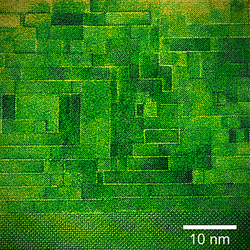 |

|
 |
Not a brick wall. Electron microscope image of a cross section of the newly characterized tunable microwave dielectric clearly shows the thick layers of strontium titanate "bricks" separated by thin "mortar lines" of strontium oxide that help promote the largely defect-free growth of the bricks. TEM image courtesy of David Mueller. Color added for clarity by Nathan Orloff. |
|
University of Maryland Professor Ichiro Takeuchi is part of an international team that has engineered and measured a new class of nanostructured materials—a family of multilayered “crystalline sandwiches”—that could enable a new generation of compact, high-performance, high-efficiency components for communications devices such as cell phones. The team’s results, the culmination of a multi-year collaboration, were recently published in Nature, the world's top weekly scientific journal.
The new multilayer crystals are “tunable dielectrics,” materials that enable cell phones and other communications devices to tune to a precise frequency, picking a unique signal out of the large jumble of possible ones.
“This work represents a demonstration of tour-de-force capabilities by the team which can be unleashed to design and discover new functional materials,” Takeuchi says. “The abilities to predict complex materials properties, synthesize them, and test their functional response across a broad frequency range, temperature and electric field, as we did here, is exactly the type of collective effort we would like to pursue more in the future. This is a good example of ‘materials-by-design.’”
Takeuchi, a member of the A. James Clark School of Engineering's Department of Materials Science and Engineering (MSE), has been working with National Institute of Standards and Technology (NIST) physicist James Booth to develop new techniques to measure these designer dielectrics. Takeuchi is a world leader in the field of combinatorial materials synthesis (“combi”), the rapid, efficient creation of large numbers of compositionally varying samples, which are then screened en masse for desired properties.
Tunable dielectrics work well in the microwave range and beyond, but have been difficult to make and have required too much power, says former Takeuchi Group member and co-lead author Nathan Orloff (Ph.D. ’10, physics). Orloff, now a materials scientist at NIST, has been working under Booth’s guidance on the project since he was a graduate student.
Modern cell phone dielectrics use materials that suffer from misplaced or missing atoms within their crystal structure. These defects interfere with the dielectric properties and lead to power loss. One major feature of the new materials, Orloff explains, is that they self-correct, reducing the effect of defects in the part of the crystal where it counts.
“We refer to this material as having ‘perfect faults,’” he says. “When it's being grown, one portion accommodates defects without affecting the good parts of the crystal. It's able to correct itself and create perfect dielectric bricks that result in the rare combination of high tuning and low loss.”
The new material has layers of strontium oxide, believed to be responsible for the self-correcting feature, separating a variable number of layers of strontium titanate. Strontium titanate on its own is normally a stable dielectric—not really tunable at all—but another bit of nanostructure wizardry solves that. The sandwich layers are grown as a thin crystalline film on top of a substrate material with a mismatched crystal spacing that produces strain within the strontium titanate structure. This makes it a less stable dielectric—but one that can be tuned.
The new material performs so well as a tunable dielectric, over such a broad range of frequencies, that the team led by Booth had to develop a new measurement technique just to describe its electronic characteristics.
“We were able to characterize the performance of these materials as a function of frequency running from 10 hertz all the way up to 125 gigahertz,” says Orloff. “That's the equivalent of measuring wavelengths from kilometers down to microns all with the same experimental set-up.”
Booth, Orloff and Takeuchi’s primary collaborators on the project were Cornell University professors Craig Fennie (Department of Applied Engineering and Physics), who predicted the strontium titanate films’ tunable properties using computational techniques; and Darrell Schlom (MSE), who grew the crystal films using molecular beam epitaxy.
Takeuchi's other co-authors on the paper included scientists from Pennsylvania State University, the Institute of Physics ASCR (Czech Republic), Universitat Politècnica de Catalunya (Spain), Oak Ridge National Laboratory, the Leibniz Institute for Crystal Growth (Germany), the University of Texas at Austin, and Temple University.
For additional perspective, see the Cornell University news story, “Tunable antenna could end dropped cell phone calls”
For the original research, see:
*C-H Lee, N.D. Orloff, T. Birol, Y. Zhu, V. Goian, E. Rocas, R. Haislmaier, E. Vlahos, J.A. Mundy, L.F. Kourkoutis, Y. Nie, M.D. Biegalski, J. Zhang, M. Bernhagen, N.A. Benedek, Y. Kim, J.D. Brock, R.Uecker, X.X. Xi, V. Gopalan, D. Nuzhnyy, S. Kamba, D.A. Muller, I. Takeuchi, J.C. Booth, C.J. Fennie and D.G. Schlom. Exploiting dimensionality and defect mitigation to create tunable microwave dielectrics. Nature, 502, 532–536, Oct. 24, 2013. doi:10.1038/nature12582.
Story adapted from “Perfect Faults: A Self-Correcting Crystal May Unleash the Next Generation of Advanced Communications” by Michael Baum, courtesy of NIST.
December 4, 2013
|